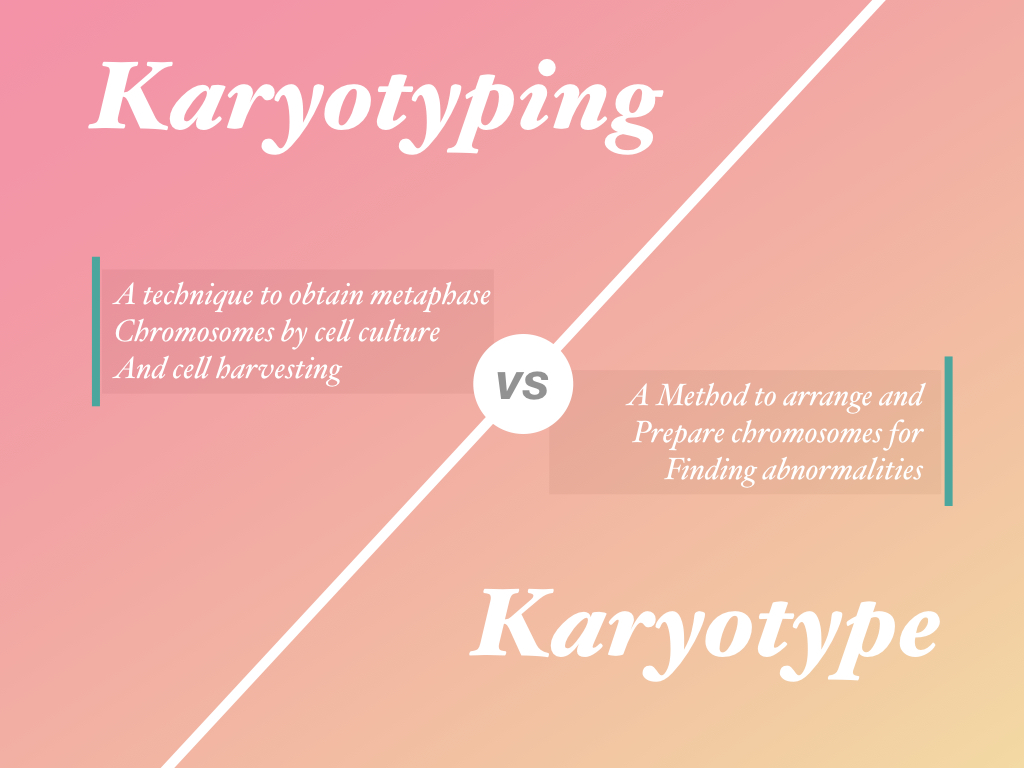A karyotyping is a process to evaluate chromosomes while a karyotype is a pictorial representation of it.
I know it is confusing.
People commonly consider karyotyping and karyotype as the same. But let me tell you practically, both techniques are different.
For common or non-scientific people both techniques are similar. But as a scientist or being a student of science we have to understand differences between both.
I know, even, that it will create controversy but after reading this article, you will understand the differences. So don’t waste more time and let’s get into the topics.
Spoiler: The present article is more technical and in-depth explained if you are looking for some basic information, read these articles first:

Karyotyping vs karyotype:
A karyotyping is a process to prepare metaphase chromosomes, in order to examine the chromosomes while a karyotype is a method to arrange it by either manual process or by computational software.
The technique karyotyping includes steps like cell culture, incubation, cell harvesting, chromosome slide preparation and bandings.
Contrary,
The method karyotype includes steps like taking a photograph of a metaphase field, analyse the karyotyping results and arranging it on a paper.
Thus, we say the karyotyping technique is more scientific while a karyotype method is less scientific, besides identifying chromosomes, we should have to do some paperwork or computer work during karyotype preparation.
The final product of karyotyping is a slide of metaphase chromosomes, on the other side, the final product of a karyotype is a sheet or computer file with chronologically arranged chromosomes.
To become an expert in karyotyping one should have to develop core cytogenetic skills like cell culture, cell harvesting, use of different chemicals and slide preparation.
However, to be an expert in karyotype, one should learn to identify the chromosomes, thus he or she doesn’t need wet lab skills.
This is the reason in some organisations a karyotyping and a karyotype expert are different. One needs to take care of the cytogenetic part while the other needs to take care of only results and karyogram preparation.
The process of karyotyping must be completed within 24 hours of sample collection, as the time increases, the chance of getting a metaphase plate decreases. On the other hand, it is not mandatory in a karyotype to complete it immediately.
Once a slide is prepared and a photograph or metaphase are taken, one can analyze results on their convenience. Even he or she can store results and send it to other experts if required.
But during the karyotyping, once you have collected a sample you have to process it anyhow or send it to another laboratory within 24 hours.
If we differentiate in terms of the process and complexity of the assay, the karyotyping technique is though one, the chance of results failure, contamination and other problems are always there.
Notably, if the culture fails, we can’t process samples the second time. Contrary, the process of karyotype preparation is less laborious and less complicated.
Once a picture is taken, it’s done, you can observe and arrange results on your convenience. Also, critical problems like reaction failure or contamination are not there in it.
Karyotyping in a nutshell:
- Sample is collected in a heparin tube.
- Cell culture using cell culture media
- Incubation of culture for 72 hours and 37C temperature
- Addition of colchicine
- Hypotonic treatment
- Harvesting cells using methanol and glacial acetic acid
- Preparing a metaphase slide.
- Send it for karyotype preparation
Karyotype in a nutshell:
- Microscopy of metaphase slide
- Scanning the slide to get chromosomes
- Taking a picture
- Printing chromosomes on a paper
- Labeling chromosomes
- Cutting each pair of chromosomes
- Sticking it on a separate paper
- Observing a karyotype to identify abnormality if any
Conclusion:
Simply put, both karyotyping and karyotype are interlinked processes, a cytogenetic expert is needed to perform both. But a person involved in karyotyping must have high wet lab work experience.
The reason for that is, in any condition, the culture should not be failed, otherwise it creates a big problem.
Conclusively we can say for some non-technical person, a karyotype or karyotyping might be a same thing but not for an expert.

